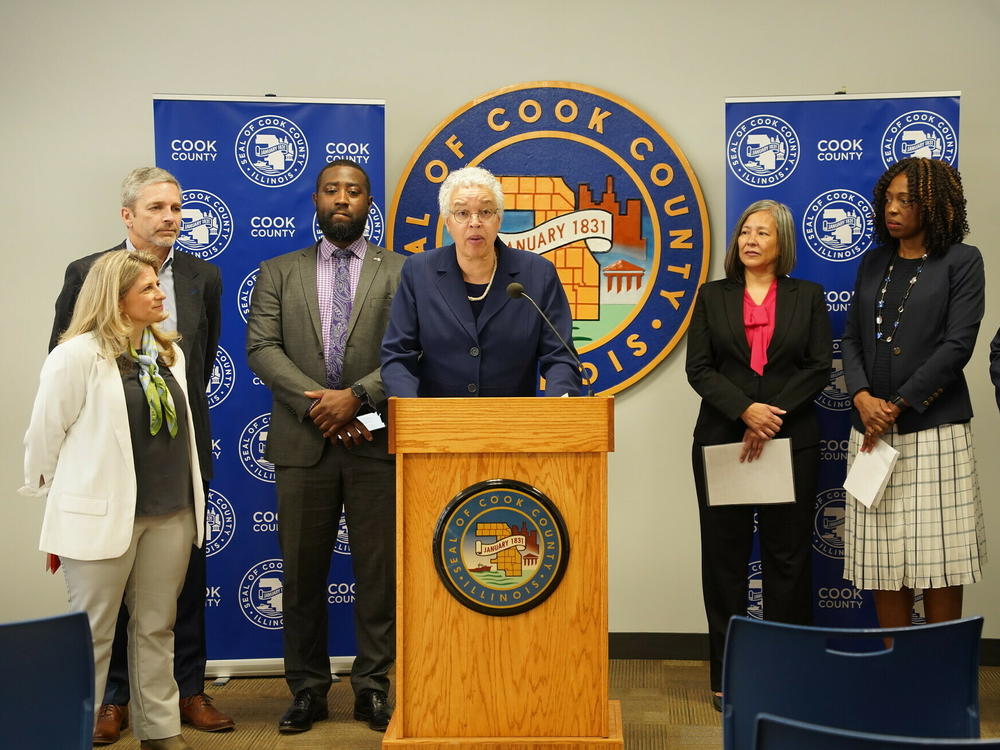Section Branding
Header Content
A growing wave of local governments are erasing billions in medical debts
Primary Content
This week, New York City pledged to pay down $2 billion worth of residents' medical debt. In doing so, it has come around to an innovation that started in with local governments in the Midwest, and is ridding millions of Americans of health care debt.
The idea emerged a couple of years ago in Cook County, Ill., home to Chicago and surrounding towns. Toni Preckwinkle, president of the county board of commissioners, says two staffers came to her with a bold proposal: The county could spend a portion of its federal pandemic rescue funds to relieve residents' medical debt.
The result: In 2022, Cook County became the first local government to partner with RIP Medical Debt, a nonprofit group that uses private donor funds to buy up and pay off health care debts.
RIP's model turns debt collection on its head: Normally, debt collectors buy unpaid bills to then try to collect the owed funds. RIP identifies unpaid hospital bills owed by people making up to four times the federal poverty level, then buys that debt on secondary markets or directly from hospitals at a small fraction of the original value. Instead of trying to collect, RIP forgives it — so it simply disappears for the patients who owe.
In the Chicago area, as it is across the country, medical debt is an ongoing problem, creating mental and financial strain that can follow patients for years. An estimated 100 million people in the country carry some form of health care debt.
Preckwinkle says the RIP Medical Debt model dovetailed nicely with Cook County's health care mission. For nearly two centuries, it has funded its own hospital and health system, Cook County Health, in part to provide care to all residents, regardless of income.
"We have a legacy commitment to delivering quality health care to people without regard to their ability to pay," Preckwinkle says.
She says that health care mission eats up nearly half of the county's $9.3 billion annual budget. The county is now in the process of spending $12 million — a tiny portion of its budget — to ultimately retire $1 billion worth of hospital bills for residents.
In the year and a half since Cook County announced its program, seven other local governments have followed suit, including Akron, Cleveland and Toledo, Ohio, New Orleans, Wayne County, Mich., Washington, D.C., and now New York City, which announced its commitment Monday.
In comments at the announcement, New York's mayor Eric Adams noted that medical debt disproportionately affects Black and Latino communities who are more likely to be uninsured or under-insured. For the city's low income residents, he said, "taking on medical debt isn't a choice."
"Working class families often have to choose between paying their medical bills or some of the basic essentials that they need to go through life," he said.
RIP is in talks with 30 additional municipalities and states, including Connecticut, New Jersey and Michigan.
Typically, RIP can retire at least $100 worth of debt for every $1 of government funds, so the local initiatives could end up wiping out several billions in medical debt. The software selects eligible patients who remain anonymous, so it's hard to know what the impact of eliminating that debt might be across a community, or for the families that benefit.
An unusual move for local government
Amber Clapsaddle says having the city of Toledo eliminate a $1,500 medical bill from three years ago has given her hope.
In the past, Clapsaddle says she looked down on those who didn't pay their bills. "I was like, 'I'll never do that,' and I judged people really hard," she says.
Then, several years ago, her entire family of five each got sick with various ailments, requiring numerous surgeries, ultrasounds, and diagnostic tests. She had insurance, but she and her husband, a warehouse worker, couldn't meet the $6,000 deductible. Clapsaddle, a social worker, realized why medical debt is such a prevalent problem: "It just takes one bill, one bad insurance plan, just one extra diagnosis to have it all fall apart."
When Toledo's program with RIP forgave some of her family's medical debt two months ago, she cried with joy and relief. She says that motivated her to negotiate with doctors' offices and her insurance company, to try to prevent herself from getting into debt again. "It's the spark that lights the fire of getting out of medical debt."
Debt forgiveness is an unusual solution for local governments. But more are taking on medical debt. That's in part because local governments had access to federal pandemic rescue funds through the American Rescue Plan Act of 2021, and RIP Medical Debt offered a quick and easy fix to distribute those funds to those most burdened by medical expenses.
Nationally, medical debt is shown to disproportionately affect people of color and people who earn less. It also contributes to a vicious health cycle, discouraging many patients from seeking preventative or follow-up care, leading to worse and more expensive outcomes.
Cook County's Preckwinkle says the pandemic only deepened racial and income gaps that affect peoples' access to health care.
"I always talk about the fact that medical debt is the leading cause of bankruptcy in the United States," she says.
Getting down to the root causes of debt
The idea of forgiving medical debt enjoys broad political support, says Allison Sesso, CEO of RIP Medical Debt, perhaps because the issue affects people of all political stripes. She says a recent survey by RIP shows its bipartisan appeal. "84% of people agreed that it is the responsibility of government to ensure health care is affordable, and that position is held by people on the left and the right."
Sesso admits debt is only one of many factors contributing to unequal access to health care, and as hospital costs continue to rise, new debts are also piling up perhaps faster than her group is able to retire it. She says RIP hopes to retire $2.5 billion worth of unpaid medical bills through various government initiatives this year, but that's a drop in the bucket of the $195 billion estimated medical debt held by Americans.
"I'm under no illusions," Sesso says. "I don't think what I'm doing is the solution to getting rid of medical debt, writ large." Medical debt is being created at high rates, she argues, and more policies — such as protecting consumers and strengthening insurance coverage — are needed to prevent medical debt at the source.
The enduring benefit of the recent local government initiatives is that they have helped draw more attention to the problem, raising its profile in useful ways, she says.
"I think the issue of medical debt is becoming a priority, local governments are talking about it," she says, and that is leading to other conversations about what else they can do to get more eligible families insured through Medicaid, or through the Affordable Care Act insurance marketplace, for example.
It is also inspiring programs like one recently adopted by Milwaukee County, Wis., which is urging more hospitals and health systems to use credit reports to screen and automatically enroll eligible patients in financial assistance programs. These programs already exist to help reduce medical expenses for patients making up to three times the poverty level, but often patients are unaware or not told to apply for them.
By automating the process, as many as 50% more patients may receive free or reduced-cost care, so they have a better chance of avoiding incurring medical debt in the first place, says Shawn Rolland, a member of Milwaukee County's board of supervisors.
"Why make it more difficult than necessary to get enrolled? Because ultimately this will make it more likely that they'll come back for preventative care."
This story is part of Diagnosis: Debt, a reporting partnership between KFF Health News and NPR exploring the scale, impact, and causes of medical debt in America. Explore the series.
Copyright 2024 NPR. To see more, visit https://www.npr.org.


